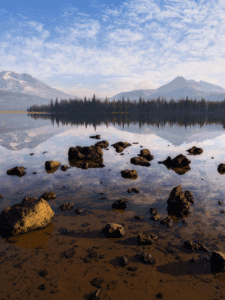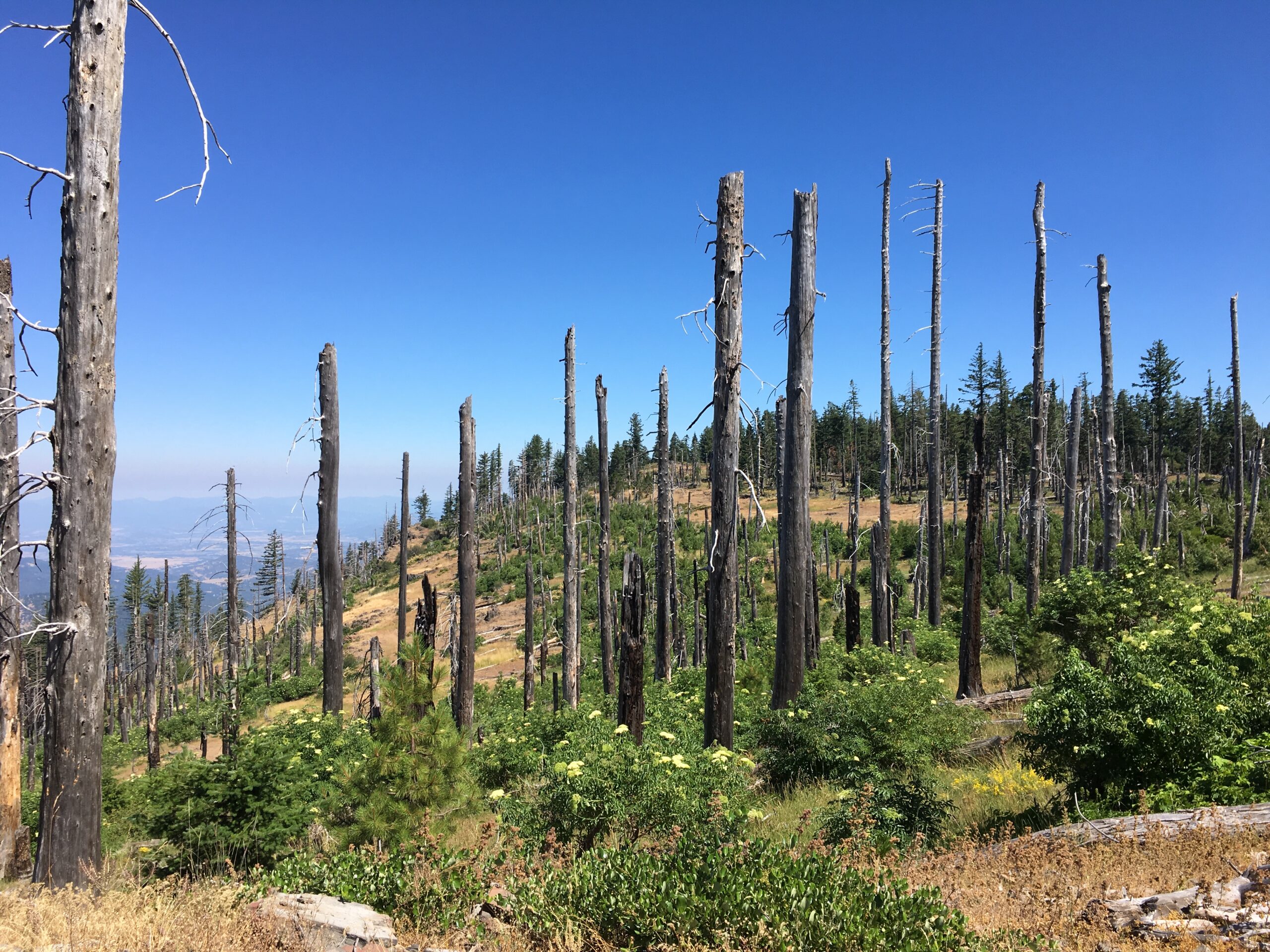By Helena Virga
Wildfires can destroy homes and induce fear, however they are vital for our forest ecosystems. Fire recycles nutrients back into the soil, provides habitat for insects and animals, and has many tree species that rely on it like lodgepole pines and oaks.
Mature and old-growth forests are the most resistant to fires, so why are they being logged?
Fire policy in the U.S. has been linked to timber interests for over a century, suppressing fires to leave more trees to log for economic gain. But, logging large trees deprives ecosystems of its most fire-resistant individuals, and leaves behind branches and tree needles that become ready-to-burn fire fuel on the ground.
Climate change and wildfire
Wildfire does not worsen climate change – in fact, wildfires only emit 5 – 10% of carbon contained in the forest1 – but climate change has and will continue to worsen wildfires.
Climate change is leading to longer, hotter, drier summers and thus an increase in wildfires and extreme wildfire behavior. Climate change brings stronger and more erratic winds that make fires move faster and quickly switch directions, which puts firefighters at risk. Climate change has increased droughts across the country, which dries plants out, leaving more fuel behind for fire to consume and increasing fire intensity. The increased droughts lead to longer fire seasons, as snow melts sooner and arrives later, leaving communities vulnerable for longer periods of the year.
Many people ask, “What can we do to prevent wildfires?” The thing is that we can’t, and we shouldn’t. Just like Florida cannot stop hurricanes, the West cannot stop wildfires.
But we can learn how to coexist with fire.
Human Fire History and Cultural Burning
Humans have been utilizing fire as a tool since time immemorial, for cooking and heating, agriculture and landscaping. Humans are the number one fire-adapted species. Did fire always invoke such strong emotions of fear?
The answer is no, and for many generations of certain cultures, that never shifted. Native Americans have been intentionally stewarding many lands with fire since time immemorial, this is known today as “cultural burning.” There are many different uses of cultural burning by different tribes today, from ceremonial to agriculture, and cultivating traditional medicines to hunting game.
Renowned Indigenous author Robin Wall Kimmerer, author of Braiding Sweetgrass, shares about the Indigenous use of fire for land management here. The Karuk tribe, cultural burn practitioners in Northern California, share the significance of Indigenous fire use for their ecosystems in this wonderful short film. Prescribed fire, fire set intentionally for the purpose of forest management or prairie restoration, and cultural burning, fire set intentionally by Native Americans for ecological and cultural purposes, are two powerful solutions to how we can learn to coexist peacefully, and powerfully, with fire.
Fire Policies
White settlers forcibly removed Native Americans from their lands and homes, and also put a stop to their intentional fire use nearly 200 years ago across the entire U.S. In addition, since the early 1900s, U.S. fire management policies have been interconnected to timber interests. With a surplus of people and equipment from wars, the U.S. began a war on wildfire. Big conflagrations like the Yellowstone Fire and the Big Blow Up in 1910 that resulted in many deaths, led to the fear of fire in the public perception and the media. In 1949, Smokey the Bear was born; the face of wildfire prevention. Because of this successful public relations campaign, many generations of Americans grew up in fear of fire and in support of unwavering fire suppression.
Today, the logging industry still uses fires to advance its agenda. Agencies say that post-fire “salvage logging” is beneficial for forests by removing “harmful” trees. They also use the term “hazardous fuels reduction” to frame logging as a mechanism for forest protection. In fact, unlogged forests with large trees are more resistant to fire, logged areas and tree plantations have higher mortality rates, and thinning out dense forests emits a lot of carbon pollution. It is important to recognize when language is being misconstrued to misinform the public.
The controversial practice of salvage logging allows bulldozers and other heavy equipment into fragile forest areas, where they clear-cut live and dead trees. This logging destroys hard-to-replace snags and wildlife habitat, impairs the first plants to emerge after fire, interferes with the development of future healthy forests, damages fragile soil, accelerates transfer of carbon to the atmosphere, and sends mud and sediment into the rivers and streams we rely on for clean drinking water2.
Keeping Communities Safe
Logging forests in the backcountry not only harms forest recovery, it also does nothing to protect homes and communities from wildfire. The solution is simple: agencies should stop funding logging in the name of fuel reduction and start prioritizing funding to communities to harden homes against fire, and focus on fighting fires only in the Wildland Urban Interface (WUI), the areas where people live and work. With over 40 million homes in fire-prone landscapes in the West, it is necessary to put communities first.
There is a lot of research that shows how we can coexist with fire, especially regarding keeping our homes, properties, and communities safe. Dr. Jack Cohen, a research physical scientist for the US Forest Service, has conducted studies on how to make homes more “firewise.”
There are many ways we can protect our homes, including reducing fuels and vegetation within 100 feet of structures, installing fire resistant roofing and ember proof vents, installing tempered glass windows and doors, and removing flammable things from near the home such as firewood and non-fire resistant outdoor furniture. People that live in the WUI can follow these steps, and more found here, to reduce potential structure-to-structure fire spread, the most common way that homes catch fire.
Education
Logging mature and old-growth trees is not the way to keep our communities safe, these big trees are not our problem but rather our solution to climate change and true forest health.
Elemental, a recently- released, critically-acclaimed documentary created by Director Trip Jennings, shares the powerful stories of those affected by wildfires, the research of fire experts like Dr. Cohen, the Native American use of fire like the Karuk tribe, and the importance of understanding the effect of climate change and wildfire. You can find the film here.
Remember, fire is necessary and natural for our forests; logging old growth forests makes climate change worse, not better; and homeowners can prepare their homes to coexist with fire. Wildlife and wild forests need wildfire.
ABOUT THE AUTHOR: Helena Virga works as the Development and Outreach Director at FUSEE- Firefighters United for Safety, Ethics, and Ecology. She has graduate degrees in Environmental Studies and Nonprofit Management from University of Oregon and interned with Oregon Wild in 2022 and 2023.
1) Law, BE, RH Waring. 2015. Carbon implications of current and future effects of drought, fire and management on Pacific Northwest forests.
2) Barnard, J. “Log After Fires? Study Fuels Debate.” NBCNews.



